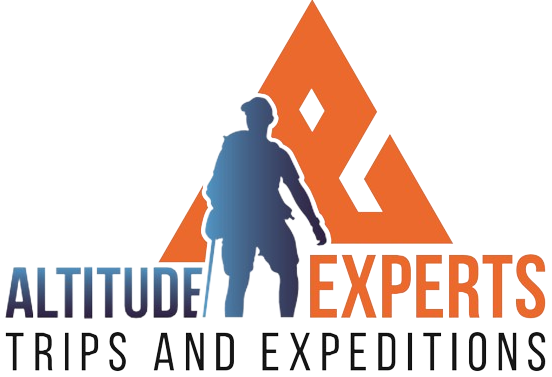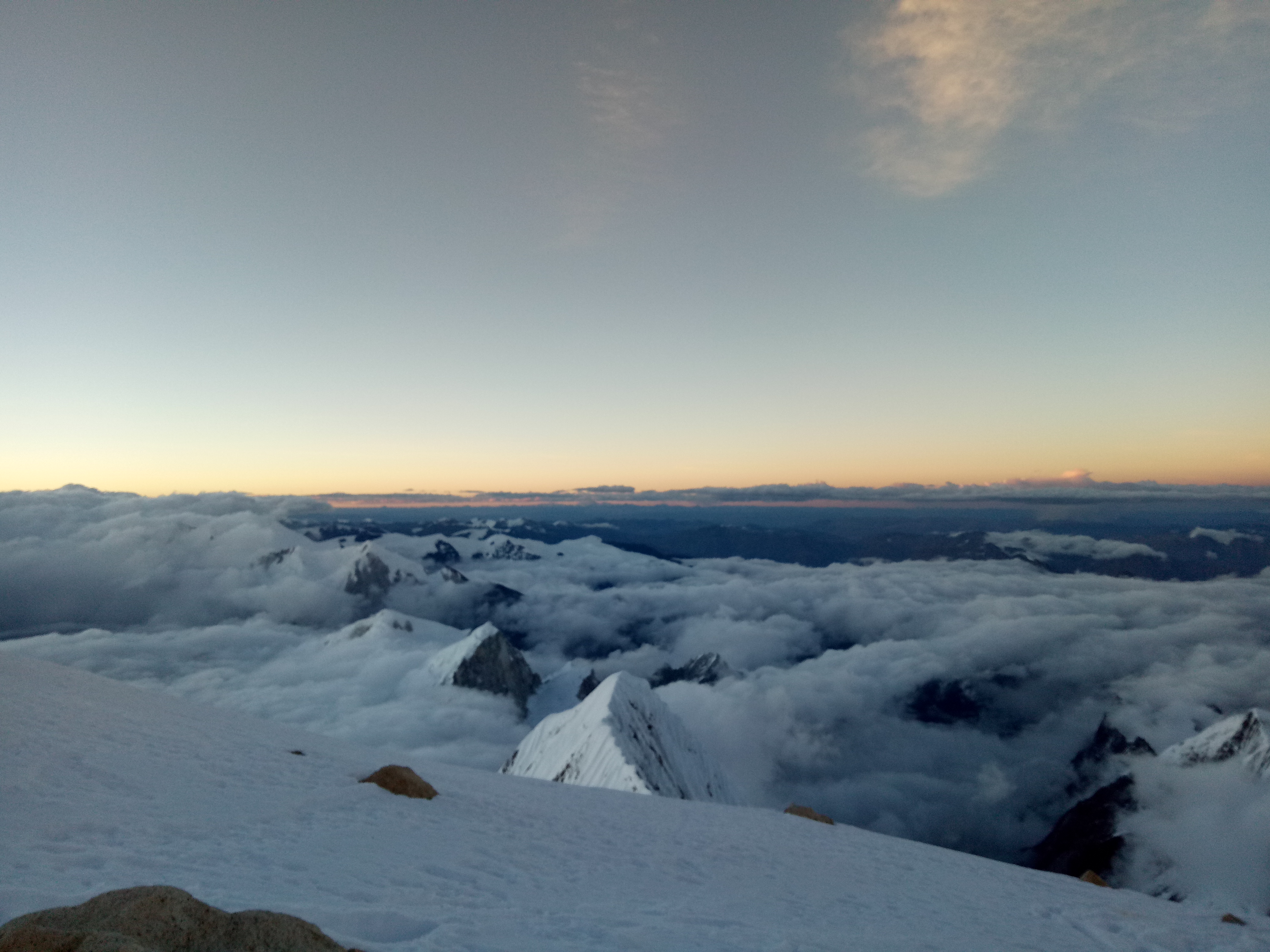8000m Peak Climbing Gear List (Expedition Standard)
|
Categories |
Item |
Quantity |
Description |
|
Technical Gear |
Climbing Helmet |
1 |
Lightweight, durable climbing helmet for head protection. |
|
|
Climbing Harness |
1 |
Adjustable alpine harness with gear loops for high-altitude climbing. |
|
|
Carabiners (Locking) |
3-4 |
Lightweight, locking carabiners for rope security and belaying. |
|
|
Crampons |
1 pair |
Lightweight technical crampons suitable for ice, mixed, and snow. |
|
|
Ice Axe |
1 |
Lightweight ice axe for self-arrest and climbing |
|
|
Ascender |
1 |
For ascending fixed lines |
|
|
Descender (Figure-8) |
1 |
Essential for rappelling on steep terrain. |
|
|
Trekking Pole |
1 pair |
Collapsible skiing/trekking poles. |
|
|
Auxiliary Cord (6mm diameter) |
4-6 meters |
For prusiking and other climbing rigging purposes, connect the safety device to your harness using a secure knot or carabiner. |
|
Foodwear |
Expedition Boots |
1 pair |
Triple-layer 8000er mountaineering boots (e.g., La Sportiva Olympus Mons or Scarpa Phantom 8000) for insulation. |
|
|
Camp Boots |
1 pair |
For prusiking and other climbing rigging purposes, connect the safety device to your harness using a secure knot or carabiner. |
|
|
Down Booties |
1 pair |
Lightweight insulated booties for camp use and rest days. |
|
|
Trekking Boots |
1 pair |
For any approaches along dry trails, it's essential to prioritize lightweight shoes that offer high comfort, ample room in the toe box, and excellent support. Street or city-style shoes are not acceptable substitutes for proper hiking footwear. |
|
|
Socks |
4-5 pairs |
High-quality merino wool or synthetic blend for warmth and breathability. |
|
|
Liner socks |
4 pairs |
Pack four pairs of smooth, thin, non-cotton socks to serve as liner socks, which should be worn beneath your wool or synthetic socks. |
|
Clothing |
Short underwear |
3-4 pairs |
Only synthetic or wool fabrics are permitted—no cotton! Bring comfortable athletic styles that suit your needs and preferences, such as boxers, briefs, or sports bras. |
|
|
Base Layer (Top & Bottom) |
3-4 pairs |
High-quality merino wool or moisture-wicking synthetic base layers. Keeps dry and warm |
|
|
Long sleeve Sun shirt |
1 |
This item must be made from a non-cotton material, such as merino wool or polyester. Light-colored, hooded sun shirts are highly recommended for sun protection and are commonly worn by guides during most climbs. |
|
|
Softshell Pant |
1 |
Choose stretchy, comfortable, non-insulated softshell pants that fit well with or without your base layer. Please be aware that "zip-off" style trekking pants are too lightweight to qualify as softshell pants. |
|
|
Trekking Pants |
2-3 |
lightweight nylon trekking pants. We recommend styles that are straightforward, made from synthetic fabrics, and include pockets for convenience. While zip-off models are not mandatory, some people prefer them. |
|
|
Hardshell Pant |
1 |
Choose non-insulated, fully waterproof shell pants that fit comfortably over your base layer and softshell pants. Full-length, separating side zippers are typically required. |
|
|
Softshell Jacket |
1 |
This breathable jacket, which is resistant to wind and weather, is an essential component of a mountaineering layering system. We recommend a hooded design. It should fit comfortably over both your midlayer and base layer tops. |
|
|
Mid layer Top |
1 |
A midweight, form-fitting fleece layer is ideal for wearing over base layers. Hoods are optional but recommended. Grid fleeces typically offer the best warmth-to-weight ratio. Additionally, lightweight puffy jackets can also serve as effective midlayers. |
|
|
Hardshell Jacket |
1 |
You will need a non-insulated, fully waterproof shell jacket with a hood. We suggest using a durable three-layer fabric. Options like Gore-Tex Pro Shell or similar eVent fabric provide excellent durability and long-lasting weather protection. This jacket should fit comfortably over your base layer, midlayer, softshell, and possibly a lightweight insulated layer. It is essential that the hood is compatible with a helmet. |
|
|
Lightweight Insulated Jacked |
1 |
Your lightweight insulated jacket can be used either as an additional layer or on its own for insulation when suitable. It can feature either down or synthetic insulation. Down is typically more compressible and lighter, while synthetic insulation maintains warmth even when wet. |
|
|
Insulated Jacket (Down) |
1 |
Expedition-grade puffy down jacket for basecamp . |
|
|
Insulated pant (down) |
1 |
Expedition-grade puffy down pant for basecamp . |
|
|
Down suit |
1 |
Expedition-grade down suit (8000m+) for extreme cold, windproof and water-resistant |
|
Hand wear |
Down Mittens |
1 pair |
Expedition-grade down mittens for high-altitude extreme cold. |
|
|
Glove Liners |
2 pairs |
Lightweight merino or synthetic glove liners for dexterity and added warmth. |
|
|
Insulated shell Gloves |
1 pair |
Gloves with a waterproof shell and removable insulated liners are ideal for conditions too cold for softshell gloves but not cold enough for expedition mittens. Look for models with a tough leather palm for added durability. |
|
|
Softshell Glove |
1 pair |
Moderately insulated gloves are perfect for situations where mittens are too hot and liner gloves don't provide enough warmth. A leather palm design is highly recommended for improved durability. |
|
Headwear |
Balaclava |
1 |
Windproof, fleece-lined balaclava for face and neck protection. |
|
|
Buff |
2-3 |
Essential for any outdoor adventure, the UV Buff is a versatile alternative to the bandana, offering a wide range of uses. |
|
|
Sun hat |
1-2 |
Any style of lightweight hat for shading the head will work well. Baseball caps and sombrero-style sun hats are the most common. |
|
|
Woolen / synthetic Hat |
1-2 |
A non-cotton wool or synthetic hat that covers the head and ears comfortably. |
|
|
Sunglasses (UV Protection) |
1 |
Category 4 UV protection sunglasses for snow glare and high UV exposure (e.g., Julbo Explorer 2.0). |
|
|
Ski Goggles (with anti-fog) |
1 |
Anti-fog goggles for high-wind and snowy conditions (e.g., Julbo Aerospace). |
|
|
Headlamp (with extra batteries) |
1 |
Powerful headlamp (300+ lumens) with extra batteries. |
|
Personal Equipments |
Sleeping Bag (High Altitude) |
1 |
Rated to -40°C, down-filled for extreme cold, high camp usage |
|
|
Sleeping Bag (Low Altitude) |
1 |
Rated to -20°C, down-filled for basecamp use |
|
|
Sleeping Pad (Foam) |
1 |
A full-length, modern inflatable sleeping pad is recommended. Older-style three-quarter length pads have been superseded by ultralight full-length pads. We recommend bringing a valve repair/body patch kit. |
|
|
Inflatable sleeping pad |
1 |
This pad should be either 3/4 or body length. |
|
|
Water Bottles (Insulated) |
2 |
Insulated bottles (e.g., Nalgene) with bottle covers to prevent freezing.(BPA-FREE) |
|
|
Pee Bottle |
1 |
Collapsible or hard-sided 1 liter Nalgene models can work well. |
|
|
Backpack |
1 |
A 50-55 liter backpack is recommended for carrying gear comfortably and efficiently. |
|
|
Thermos |
1 |
We highly recommend bringing a stainless steel, vacuum-sealed thermos with an airtight and thermal cup lid, especially for those who like to drink hot water for hydration during cold mountain days. A one-liter thermos is ideal, and it's better to opt for a wide-mouth design, as narrow-mouthed ones can be harder to fill. |
|
|
Mug |
1 |
To be used for drinking tea and water at higher camps. |
|
|
Bowl |
1 |
A packable bowl is essential. Bowls with lids, such as Tupperware, are convenient, but lidless or flatter, deep plate-style models also work well. |
|
|
Spoon |
1 |
One durable hard plastic or anodized metal spoon. Longer spoon stems can be helpful for eating while wearing gloves. |
|
|
Knife |
1 |
Medium-sized. Keep it simple and light. |
|
|
Large Duffel bag |
2-3 |
To store and transport all your gear, a waterproof option is highly recommended. |
|
|
0.5 L. Water bottle (Optional) |
1 |
0.5L "baby" Nalgene bottle can be used instead of a traditional mug. Its leak-proof lid allows you to store it in your pocket or jacket, helping to keep both the bottle and you warmer. Bottles should have a wide mouth and be made of co-polyester (BPA-free plastic). |
|
|
Solar Panel+ Power bank |
1 |
Bring a small portable solar panel and power bank to charge personal items, like a cell phone, on longer trips without power access |
|
|
Toiletry Bag |
1 |
Pack toilet paper (in a plastic bag), hand sanitizer, toothbrush, toothpaste, floss, wet wipes, and personal medications. Select quantities based on your trip length. Female climbers should also bring sufficient feminine hygiene products for the duration. |
|
|
Water treatments |
|
Carry a SteriPEN or enough water treatment tablets for safe drinking water for your trek to basecamp. Carry a SteriPEN or enough water treatment tablets for safe drinking water. |
|
|
Sunscreen (High SPF) |
|
High SPF 50+ sunscreen to protect from intense UV rays at high altitude. |
|
|
Lip guard |
|
Several tubes of SPF30+ Lips cream. |
|
|
Running Shoes |
1 |
Lightweight, comfortable running or walking shoes are recommended for off-mountain use and pre-and-post trip travel. In some situations, these may also serve as approach shoes. |
|
|
Camera and extra batteries |
|
|
|
|
Personal First Aid Kit |
|
Basic medical supplies in a compact package. We recommend over-the-counter pain relievers, Moleskin, first-aid tape, Band-Aids, and anti-septic wipes or gel. |
|
|
Medications & Prescriptions |
|
Bring personal prescriptions along with Diamox (125mg), Immodium, cold medicines, and a variety of over-the-counter pain relievers like Ibuprofen.. Additionally, pack hard candies and cough drops for the cold, dry air. |
|
|
Hand Sanitizer |
|
Alcohol-based hand cleaners. Bring a small amount appropriate to the trip duration. |
|
|
Shower gear |
|
A compact, packable towel, shower sandals, and a small bottle of soap or shampoo are great for maintaining personal hygiene during the trip. |
|
|
Hand and Toe Warmer |
3 set each |
|
|
|
Snacks |
|
All meals for the trip will be provided, but be sure to pack any snacks or additional food and drink items you prefer to have on hand while climbing! |
|
Pre &Post Climb |
City Cloths |
|
We recommend packing clean "city" clothing for travel and for use before and after the trip. Bring a comfortable assortment of clothing, including some t-shirts, for added peace of mind. |
|
|
Small Duffel bag |
1 |
To storage your city cloths and other unnecessary belongings in Kathmandu. |




